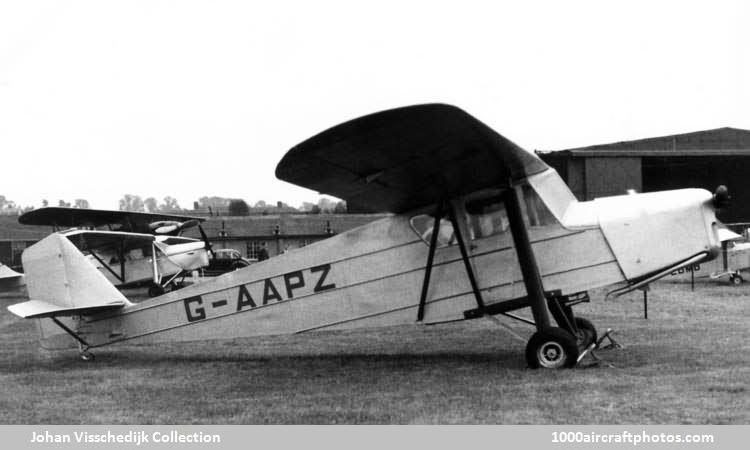07/31/2011. Remarks by Johan Visschedijk: "Marcel Desoutter re-entered aviation in 1929 to form a company for manufacturing Frederick Koolhoven's F.K.41 under license. This Cirrus III powered three-seat, high-wing monoplane was of wooden construction with plywood fuselage and fabric covered wing. The second F.K.41 built, G-AAGC, arrived at Croydon in April 1929 for modification by the Desoutter Aircraft Company's chief engineer, G.H. Handasyde.
The high-set tail plane was lowered to the thrust line and the windscreen and engine cowlings were remodelled. In this form it was exhibited without markings as the Desoutter Dolphin at the Olympia Aero Show of July 1929, and a month later the third Dutch-built F.K.41 arrived to become G-AALI. This had the lowered tail plane and also additional fin area, and was immediately exported to Australia, where it reverted to the high-set tail plane and acquired a heavy-duty landing gear.
The name Dolphin was not used again, and the machines built at Croydon, in part of the former Aircraft Disposal Co. factory, were fitted with Cirrus-Hermes I engines and known simply as Desoutters. National Flying Services Ltd. (NFS) placed a large order and eventually received 19, which in black and bright orange soon became a familiar sight at their nationwide chain of flying clubs, where they were used for instruction, pleasure flights and taxi work.
The fleet rapidly dwindled, G-AAPP went joy-riding at the Cape, G-AAPY was sold to M.D.L. Scott at Skegness, two went to Belgium, G-AANC crashed, and when the firm ceased operations in 1933 the rest were sold. G-AAPT went to Rollason Aircraft Services Ltd. at Croydon, where it was fitted with a de Havilland Gipsy I engine and long exhaust pipe. G-AAPU was sold to Aero Research Ltd., Duxford, and G-AANE toured with the National Aviation Day displays.
The first non-NFS Desoutter, G-AATI, left Croydon for New Zealand on February 9, 1930, piloted by H.L. Piper and C.E. Kay. With very little trouble they completed the journey to Sydney on March 23 and shipped the Desoutter to New Zealand, where it continued in use for nearly 20 years. Its days ended with Blackmore's Air Services Ltd., taking tourists to view the volcanic wonders of Rotorua, where it was damaged beyond repair in a crash-landing in 1950.
There were only four other early Desoutters in British employ: G-AATF with Air Taxis Ltd., G-AAWT which Vivian Holman demonstrated for Cirrus Aero Engines Ltd. and two suitably decorated ambulances. These were G-ABMW and G-ABRN, owned by the British Red Cross Society, the first based at Croydon and the other at Woodford. When the Society closed down its aviation department, they became taxi aircraft with Imperial Airways and the Lancashire Aero Club respectively.
In 1930 an improved version, the Desoutter II, was built with a Gipsy III engine, redesigned ailerons and tail surfaces and fitted with wheel-brakes. The prototype, G-AAZI, first flew in June 1930, after which the earlier model automatically became the Desoutter I. Thirteen of the new version were built, and of the seven British, the prototype alone saw lengthy service and became well-known at Croydon in Rollason's blue. After a period with R.O. Shuttleworth at Old Warden in 1938, it was impressed and finally scrapped at Twinwood in July 1944.
First of the others was EI-AAD, which, after a year in Ireland with Iona National Air Taxis, went to Australia as G-ABOM in January 1932, registered VH-UEE, in 1951 it became VH-BQE, and is now on display at Western Junction Airport, Launceston, Tasmania. Miss Winifred Spooner and Flying Officer E.C.T. Edwards acquired G-ABCU for an attempt on the Cape record, but after a non-stop flight to Rome, forced-landed in the Mediterranean and the wreck was burnt at Heston in May 1931.
G-ABDZ and G-ABIG were sold abroad, the latter to Northern Aviation Ltd. in Northern Rhodesia, and Major I.N.C. Clarke was killed at Stranraer when G-ABFO of Personal Flying Services Ltd. struck a hill in fog in May 1932. Up till the outbreak of war the surviving Desoutter Is were driven hard.
Cirrus Aero Engines Ltd. fitted their new inverted Cirrus-Hermes IV into G-AAWT before it went to the Dutch East Indies in 1933. E.D. Ayre installed a Cirrus-Hermes II in the ex-NFS G-AAPZ and almost won the 1933 King's Cup. He flew a magnificent race, averaging 115.89 mph (186.51 kmh), and was only beaten into fourth place in the last seconds.
The sole UK survivor of an interesting breed is this very G-AAPZ, delivered to the NFS in 1931. It was acquired by Richard O. Shuttleworth in 1935 and since fitted with Desoutter II tail-surfaces, modified windscreens, new landing gear, larger fuel tank, extra instruments, and a Menasco Buccaneer engine. The registration was cancelled on December 1, 1946.
In 1985 volunteers with the Shuttleworth Collection started a restoration to the original Desoutter I configuration in the markings of the NFS, culminating in a second maiden flight on January 26, 1998. Since it is regularly flown at air displays, as seen in this photo."
